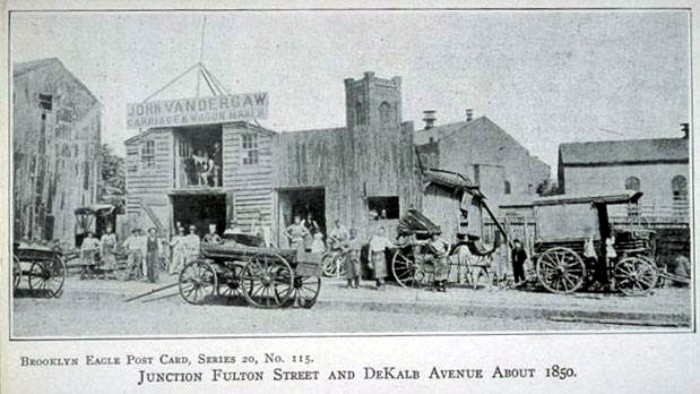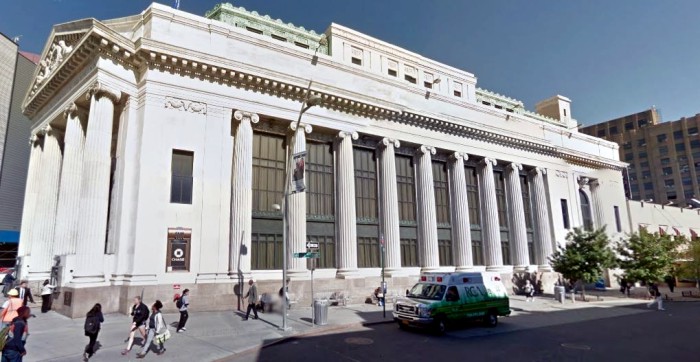Past and Present: John Vandergaw, Carriage and Wagon Master
A look at Brooklyn, then and now. Long before the Dime Savings Bank, long before City Point, the Albee Square Mall that preceded that, and the Albee Theater that preceded the mall, and on back into the 1850s, when this area was more like a small town than a big city, a man named John…


A look at Brooklyn, then and now.
Long before the Dime Savings Bank, long before City Point, the Albee Square Mall that preceded that, and the Albee Theater that preceded the mall, and on back into the 1850s, when this area was more like a small town than a big city, a man named John Vandergaw had a thriving establishment on this site. He made carriages and coaches, a much needed product for a growing city of Brooklyn.
Today’s “Past” photograph dates from a bit after 1850, and is one of the oldest photographs I’ve featured here. It is part of a series of postcards assembled by the Brooklyn Eagle newspaper. Their postcards, which were mostly a collection of photographs taken for news stories, were packaged in sets, and sold through the paper and by retailers in the early 20th century. The collection is quite eclectic, with photographs of schools, churches, banks, important civic buildings, a few mansions of the rich, and several older photos, like this one, that they discovered in their archives.
Thank goodness John Vandergaw had such a large sign above his establishment. He was a very prominent businessman in his day, and was mentioned in the newspapers enough to get a real sense of his business, as well as life in Brooklyn during the middle of the century. Vandergaw made wagons, coaches and carriages at this location. Brooklyn was growing rapidly at this point in time, and he must have kept his workers busy filling orders for new vehicles, as well as repairing existing ones.
He was located at the junction of Fulton Street and DeKalb Avenue, an intersection that no longer technically exists, but would have been where the Dime Savings Bank is today. This was not Victorian-era brownstone Brooklyn yet, but a small city built primarily of wood framed buildings. The only masonry building in the photograph is the Fleet Street Methodist Episcopal Church in the background, which once stood 43 Fleet Street, at the corner of what is now Flatbush Extension.
John Vandergaw’s father had been a carriage maker, establishing his business in New Lots in 1832. In addition to making wagons and carriages, the Vandergaw patriarch was not above making coffins and other wood pieces, as well, as evidenced by his account books which were meticulously kept and preserved, and referenced in a 1926 article in the Brooklyn Eagle, which ran this photograph in their story. Vandergaw, Jr. moved the business here to DeKalb Avenue around 1850, right before this picture was taken.
In 1863 Vandergaw went into a partnership with a man named Henry S. Wood, fittingly enough. It didn’t work out, though, because two years later, in 1865, a second notice in the Eagle announced the dissolution of that partnership. Vandergaw kept his business in the same location. Who knows what he was doing wrong, or the circumstances, but in January of 1874, John Vandergaw declared bankruptcy. He sold of some of his property to Henry Wood, laid low and rearranged his finances.
In 1885, the Eagle announced a new corporation which was selling stock; the Vandergaw Carriage Manufacturing Company. John and his son George were the principles in the company. The company was located in the same location, so he must have been able to keep it together through his financial difficulties. The family also lived nearby, at 14 St. Felix Street. It was there that John Vandergaw died in 1907.
His sons George and Ambrose had already taken over the business by their father’s death. Early in the 20th century, they saw the handwriting on the wall and had eased away from carriage production and had embraced the automobile. According to the Eagle in 1926, the Vandergaws were now in the “automobile coach business.” I assume that to mean they were now selling cars, but it could also mean they were doing some kind of servicing or custom business. They were now at 123 DeKalb Avenue, which would have put them up the street from the location of the photograph, across from Brooklyn Hospital.
George died in 1935. His death was the aftermath of an automobile accident in 1929. His obituary said that he and been in his father’s carriage manufacturing business for over 50 years. Ambrose died a year later, in 1936. He also was in the carriage business for the same length of time. He suffered a massive heart attack and died at his home at 50 South Portland Avenue. The business that had made the Vandergaw name a well-known one in Brooklyn for a hundred years seems to have died with them.
All of the buildings in this 1850s photograph are long gone. If we didn’t have the location printed on the postcard, we might never have placed the location. Today, the Dime Savings Bank stands where the Vandergaw men once built carriages and wagons. It was built in 1905-1906; designed by Mobray & Uffinger. It was expanded and revised in 1931-32 by Halsey, McCormack & Helmer, who gave us the building we have today. Thankfully, it is landmarked, and won’t be replaced by a tall residential tower, although it will be surrounded by them in no time at all.











What's Your Take? Leave a Comment